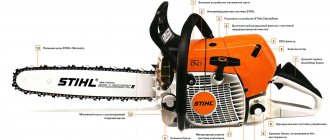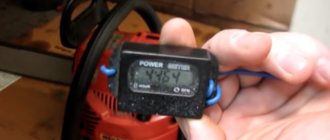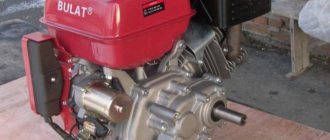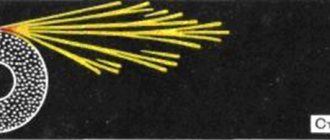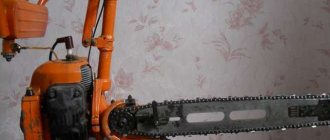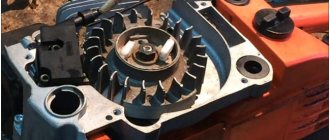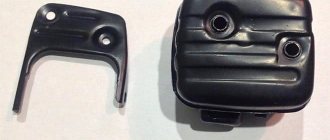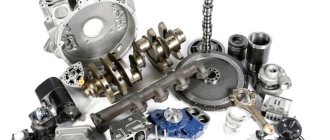A chainsaw is a useful household tool that is appreciated by many. It is easy to use and does not require any complex manipulations. If a chainsaw stalls, the reasons may be different - from the wrong fuel to a breakdown of the carburetor or cylinder-piston group. The solution to the problem also varies: sometimes it is enough to mix oil and gasoline in the correct proportions or replace the gasket, and sometimes you will need to replace parts.
A chainsaw may suddenly fail Source routestofinance.com
Most common reasons
A chainsaw is considered a fairly simple and trouble-free tool, but it can suddenly stop working. The reasons why a chainsaw is difficult to start and stalls can be different: from low-quality gasoline to serious problems. Most often, you can find the cause on your own, but in some cases you will have to contact a specialist. It is important to remember that you cannot operate a faulty chainsaw.
Fuel mixture
The most common reason for failure is a problem with gasoline or oil. It is necessary to use fuel of the brand recommended by the manufacturer. When choosing oil, you should choose oils with special additives. Manufacturers usually recommend choosing AI-92 gasoline and two-stroke oil.
The second reason is quantity. If there is too little gasoline, the chainsaw will not start; if there is not enough oil, the tool blade will jam, after which it will stop working.
In addition, it is important to maintain the proportions of gasoline and oil. They are indicated in the instructions for the tool. Most often, 25 ml of oil is required per liter of gasoline.
High-quality fuel is the key to long service life Source amazon.com
Filters
The reason why the chainsaw does not pick up speed and stalls may be a dirty air filter. It does not allow air to pass through in the amount that the tool needs for high-quality work. Initially, the carburetor is configured to mix a certain amount of incoming air and gasoline. When the filter is dirty, the amount of incoming air decreases, but the amount of gasoline remains the same. The result is an enriched mixture.
The filter also needs to be changed depending on the time of year:
- In summer, when the air is dry, use a cotton filter;
- The HD2 filter is used when working in winter or in dusty conditions, for example, when logging large quantities of timber.
When the fuel filter is dirty, the situation is the opposite: the amount of fuel decreases and the mixture becomes leaner. The uniform supply of fuel is disrupted, and the chainsaw stalls when you press the gas.
Air filter for chainsaw Source drel-master.ru
Spark plug
When figuring out why the chainsaw stalls at idle, you should immediately check the spark plug. It is an important part of the tool. There may be several problems with it:
- It may become filled with oil or fuel during the startup process. This happens especially often when inexperienced craftsmen do not follow the startup sequence. You need to unscrew the spark plug and let it dry or screw in a new one.
- The candle may become covered with soot due to prolonged use. To prevent this from happening, the spark plugs must be cleaned regularly with a wire brush or fine-grit sandpaper. It is also worth changing the spark plugs regularly.
- There may be problems with the spark plug tip. This is easy to check: you need to unscrew the spark plug and pull the starter cord. If a spark appears, then the spark plug and electronics are ok. If there is no spark, the problem may be due to depressurization of the pipes or a clogged fuel filter.
- The problem may be due to a violation of the gap between the magneto and the ignition coil. The gap size is indicated in the instructions for the tool; on average it is 0.5-0.65 mm. The problem may arise from working in difficult conditions where the saw is subject to shock.
Spark plug filled with oil Source renault-portal.ru
See also: Catalog of companies that specialize in designing and performing landscape work of any complexity
Breather
If the chainsaw does not hold idle speed, it is worth checking the breather. This is a small valve, a hole in the saw's gas tank through which air passes. Thanks to this, a vacuum does not form in the tank, and the tool works without interruption. The breather can be located in the tank lid or in the wall.
When the breather is clogged, a rarefied atmosphere is created inside. Because of this, gasoline does not pass into the carburetor. It happens that the primer (this is a pump for pre-feeding fuel) pumps a small amount of gasoline into the carburetor, and the chainsaw starts. But after the carburetor runs out of gas, the tool stalls because a clogged breather prevents fuel from passing through.
Carburetor
If your chainsaw stalls, the problem is most likely in the carburetor. This part accounts for about half of all cases.
Problems may include:
- The injectors, channels, filter, and jets are clogged. This is often due to low-quality fuel. The filter is not able to clean gasoline from impurities and debris, which leads to clogging of the jets. Gasoline stops supplying in the required quantity, or even stops supplying altogether. At the same time, the saw loses a lot of power and soon stops working completely. To fix the problem, you will have to disassemble and clean the carburetor.
Instrument disassembly may be required Source svenezia.co.il
- If the chainsaw stalls when “hot”, it is worth checking whether the rubber seal in the accelerator pump is damaged. This leads to additional air entering (“suction”), which causes the speed to increase, and soon the tool stalls. The problem is solved by replacing the cuff. It happens that replacing the cuff does not solve the problem - air continues to “suck in”. If you cannot determine where the air is coming from, you will have to replace all gaskets and seals.
- The accelerator pump needle began to stick. The cause may be wear and tear or foreign objects getting inside. The saw will stop starting or start turning off during operation.
- The check valve needle does not fit tightly to the seat. In this case, the chainsaw will begin to stall when the load increases, it will work poorly and unstably, and the spark plugs will begin to flood. It is not possible to repair the needle; it is better to replace the entire carburetor.
The problem may also be due to improper carburetor adjustment.
Adjusting the carburetor when the engine stalls when revving up
If the check shows that the fuel supply system, muffler and spark plug are working properly, then you need to look for a breakdown in other places. Initially, do not rush to disassemble the cylinder-piston group or change the carburetor. It is recommended to start repairs by adjusting the carburetor. For this, all chainsaws have special adjustment screws. They are designed to adjust idle speed, as well as adjust fuel supply at low and high speeds. A detailed description of how to adjust the carburetor of a chainsaw is described on the website.
Today we will look at the features of setting the carburetor at maximum speed. You can make sure that the chainsaw is not developing full power using a tachometer. If there is no device, then you can make sure that the engine is not developing maximum speed by ear. We are interested in the screw on the carburetor. Which is designed for high speed settings. It is usually denoted by the Latin letter "H", which is short for the word "High" (high or large).
To set up high speed chainsaws you will need to perform the following manipulations:
- Screw screw H clockwise until it stops
- Next you need to loosen it by 1.25-1.5 turns
- Start the tool and test the speed performance
It is recommended to make the adjustment using a tachometer, but if you don’t have one, you can check the maximum speed when working with the tool under load.
This is interesting!
If you often work with a chainsaw, then you will need to purchase a tachometer, as it allows you to set the engine to operate as efficiently as possible, which affects the fuel consumption and power of the unit.
After simply adjusting the carburetor, you can fix the problem with the engine stopping when the speed increases. It should be noted that the chainsaw carburetor must be adjusted regularly depending on the frequency of use of the tool. It is not difficult to do this yourself, but precise adjustments can be achieved in one case - if you use a tachometer.
Briefly about the main thing
A chainsaw is not a necessary tool in the household, but it greatly simplifies life in various situations. It is easy to use and easy to maintain, but at times the saw may stop working.
I've had problems several times. The first time, I, still an inexperienced master, mixed gasoline and oil in the wrong proportions and filled the spark plugs. I had to replace them completely because I bent the contacts while cleaning them. In the second, the chainsaw suddenly began to stall when heating up. I had to check the muffler and carburetor, then review all the gaskets and seals, and replace one of them.
I would like to give a little advice to everyone who has just started working with a chainsaw. If a problem arises, you should first check the oil and gasoline levels, the proportions of the fuel mixture, and only then climb inside. You also need to store the tool properly (be sure to drain the oil and gasoline for the winter) and regularly check it before use.
Why is it heating up?
In some cases, during operation, you may notice that the tire heats up excessively; there are two reasons for this phenomenon. The first is a manufacturing defect. Such parts are equipped with low-quality bearings, which heat it up during operation. A defective part will heat up and nothing can be done about it, only replace it with a new one.
The second reason is, again, not enough lubrication, or its complete absence. If signs of overheating appear, such as melting of the paint on the tip of the tire and strong smoking, you should stop using the tool and contact a service center.
This is what an overheated chain looks like
The choice of chainsaw tire largely depends on the characteristics of the chainsaw itself. You should only choose components recommended by the manufacturer, taking into account the pitch of the drive sprocket, the width of the chain groove and the shape and size of the shank. The key to long-term service of a chainsaw saw set is the uninterrupted supply of a sufficient amount of lubricant of the appropriate brand. Excessive wear of the bar and chain, as well as their heating, is a sign of improper operation of the saw chain lubrication system. We have highlighted the main points of choice, remember them and take them into account when purchasing, and then you will definitely buy what you really need.
Gasoline is not supplied
To find the source of the breakdown and determine why the device does not pump gasoline, disconnect the gas line from the carburetor. Try pumping fuel. If it feeds slowly, problems may include:
- in the fuel filter, it is clogged with debris;
- in contamination of the gasoline supply channel.
Experts do not fill the container with fuel to the brim. This may damage the device.
Smokes
If your equipment smokes or loses power, pay attention to the engine. Its breakdown may also be indicated by unstable starting, overheating
Why does the chain on a chainsaw jam?
The reasons why the chain on the chainsaw does not spin may be damage to the drive sprocket and burning of the tip of the saw guide. First of all, you need to inspect the clutch. If the drive sprocket exhibits uneven tooth wear, cracks, or other defects, the sprocket must be replaced.
If after this the chainsaw chain jams and breaks, then you need to inspect the tire. Burning of its tip, as well as any other part of the guide, leads to increased heating and displacement of the chain. While rotating on the bus, the headset shifted to the side gets wedged. This is evidenced by cases in which the chain stretches on the chainsaw precisely in those places where the operator had previously discovered that the guide was burning and melting.
The cause of blade burning is most often a breakdown of the lubrication system of the cutting set. In this case, it is necessary to carefully inspect the oil pump and also rinse it of debris or frozen lubricant.
The chain does not rotate
Why doesn't my chainsaw chain rotate when the engine is running even at full speed?
- Leading sprocket. Either it is jammed, or the crown is worn out so much that it is not affected and the chain
does not spin on the chainsaw. In any case, you need to reassemble the sprocket to find out the exact reason why the chain does not turn. If the crown is worn out, it is necessary to replace the sprocket (or the crown, if the sprocket has a prefabricated structure). - The brake chain is jammed. As a result, the sprocket is blocked by the brake mechanism, while the motor runs. Stop the engine and release the brake. If this happens under load, the brake mechanism will have to be changed, as well as the sprocket, since due to the high temperature, many elements can melt and overheat.
Air filter clogged
The main reason for a clogged air filter is fine dust generated when sawing wood. Cutting raw wood is especially hard. Of all the reasons for a chainsaw stalling, this is the most common. The exception is some models. For example, a “Calm” chainsaw stalls for various reasons, but not because of a clogged air filter. Because its carburetor is equipped with a compensator that takes in air if the filter fails. Wood dust particles penetrate under the housing and are sucked into the filter installed on the carburetor. A clogged mesh creates resistance to air, and less air enters the carburetor. In order to clean the air filter, it is necessary to remove the closing cover and separate it from the carburetor.
Before removing, you need to brush off the sawdust or blow with air. Then remove the filter so that debris does not get into the carburetor. During cleaning, cover the carburetor with a cloth. Then the filter must be blown out from the inside with compressed air, and then installed in place.
No spark: ignition system problems
Usually, when looking for the reason why a chainsaw stalls, the first thing they look for is the spark on the spark plug. Often saw owners simply forget to change spark plugs on time. But it depends on how stable and economical the tool will work. If the chainsaw is used intensively, then the spark plug needs to be changed once a season.
If no defects in the spark plug are found, there is confidence in high-quality contact between the high-voltage wire and the spark plug cap, but there is no spark, then there is a problem in the electronic ignition unit. It is difficult for a person without an electrician's education to understand anything there. This unit is easier to replace entirely.
Tools and materials
Diagram of a two-stroke chainsaw engine.
The design of mechanical components of chainsaws is characterized by good reliability and maintainability. Almost all units and parts have free access. If the necessary equipment is available, they can be easily removed for repair or replacement. To disassemble and check the life support systems of a chainsaw engine, you should stock up on the following tools and materials:
- a set of plumbing and assembly tools;
- socket wrench;
- tester;
- pressure gauge for measuring compression;
- probes for measuring gaps;
- needle;
- sandpaper;
- fuel mixture (gasoline + oil);
- rags.
